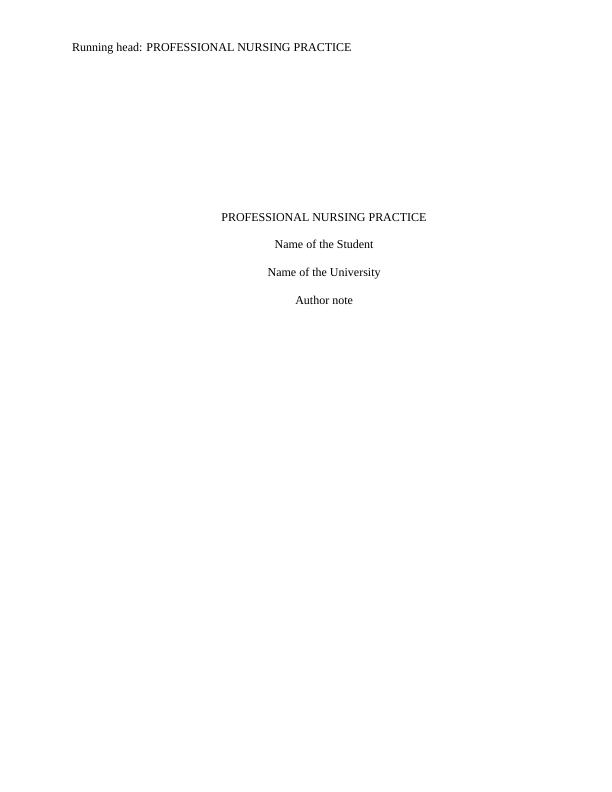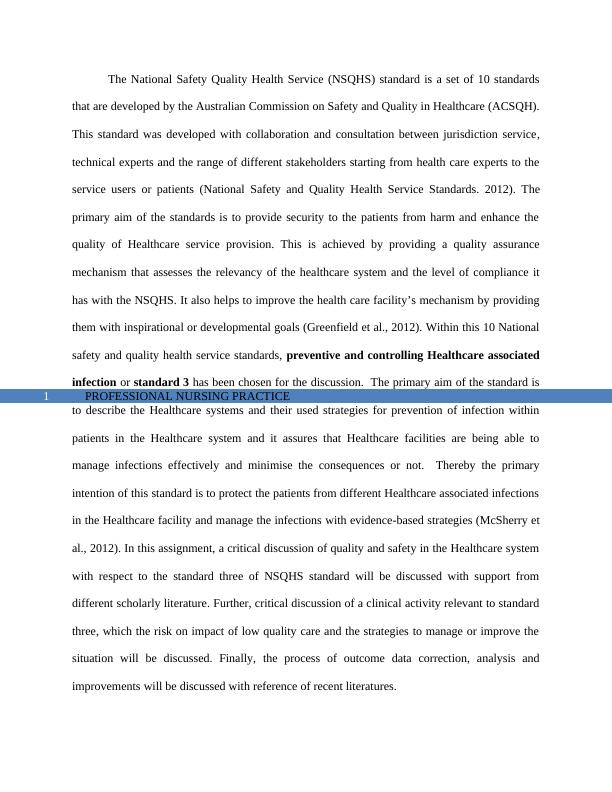Professional Nursing Practice - PDF
14 Pages3287 Words35 Views
Added on 2021-05-31
Professional Nursing Practice - PDF
Added on 2021-05-31
ShareRelated Documents
Running head:PROFESSIONAL NURSING PRACTICEPROFESSIONAL NURSING PRACTICEName of the StudentName of the UniversityAuthor note

PROFESSIONAL NURSING PRACTICE1The National Safety Quality Health Service (NSQHS) standard is a set of 10 standardsthat are developed by the Australian Commission on Safety and Quality in Healthcare (ACSQH).This standard was developed with collaboration and consultation between jurisdiction service,technical experts and the range of different stakeholders starting from health care experts to theservice users or patients (National Safety and Quality Health Service Standards. 2012). Theprimary aim of the standards is to provide security to the patients from harm and enhance thequality of Healthcare service provision. This is achieved by providing a quality assurancemechanism that assesses the relevancy of the healthcare system and the level of compliance ithas with the NSQHS. It also helps to improve the health care facility’s mechanism by providingthem with inspirational or developmental goals (Greenfield et al., 2012). Within this 10 Nationalsafety and quality health service standards, preventive and controlling Healthcare associatedinfection or standard 3 has been chosen for the discussion. The primary aim of the standard isto describe the Healthcare systems and their used strategies for prevention of infection withinpatients in the Healthcare system and it assures that Healthcare facilities are being able tomanage infections effectively and minimise the consequences or not. Thereby the primaryintention of this standard is to protect the patients from different Healthcare associated infectionsin the Healthcare facility and manage the infections with evidence-based strategies (McSherry etal., 2012). In this assignment, a critical discussion of quality and safety in the Healthcare systemwith respect to the standard three of NSQHS standard will be discussed with support fromdifferent scholarly literature. Further, critical discussion of a clinical activity relevant to standardthree, which the risk on impact of low quality care and the strategies to manage or improve thesituation will be discussed. Finally, the process of outcome data correction, analysis andimprovements will be discussed with reference of recent literatures.

PROFESSIONAL NURSING PRACTICE2After the creation of national safety and quality health service standards, the Healthcarefacilities are being provided with a quality assurance mechanism that helps to determine therelevancy of the system and ensures that safety and quality standards are met (Slimings et al.,2014). The implementation of national standards in Healthcare facilities also helps inimprovement of Patient Safety especially in case of hospital-acquired infections. The Healthcarefacilities are being pushed to monitor and take proper action against safety and quality relatedissues. They are also involved in designing user-friendly quality processes so that the affectedsystem can be improved and continuously monitored through clinical audits and interventions(Runciman et al., 2012). The standard 3 of NSQHS determines that 30 to 40% of hospitals inAustralia prescribed antibiotics. However, within that there are Healthcare facilities that do notprescribe appropriate type of antibiotics, its dose and duration. Hereby, leading to resistance toantibiotics and decreasing the patient’s ability to fight microbes or infections. Therefore, theHealthcare facilities are using antimicrobial stewardship program (AMS) in which the use ofantimicrobials can be optimised through activities such as feedback, audits, comparingprescribed antibiotics to peer’s, prescribing restrictions. Therefore, those Healthcareprofessionals can double check the prescription before handing it over to the patients. TheAustralian Bureau of statistics has determined that after the implementation of AMS, hospitalsare focused to identify the reason of long patient stays and determine the effectiveness of theirmedication system (Zingg et al., 2015). Following are the data acquired from The State of Safetyand Quality in Australian Health Care (2016).

PROFESSIONAL NURSING PRACTICE3Australian Commission on Safety and Quality in Healthcare (2018)

End of preview
Want to access all the pages? Upload your documents or become a member.
Related Documents
Practise in the Domiciliary Health Care Environmentlg...
|5
|1179
|61
Quality Health Service (NSQHS) - HNN120lg...
|5
|1170
|69
(solved) Nursing Essay Writinglg...
|10
|3028
|306
Partnering with Consumers Standard in Australian Healthcare Systemlg...
|12
|3152
|437
The National Safety and Quality Health Servicelg...
|5
|1137
|149
Assignment about Nursing Practicum Experiencelg...
|7
|1651
|15
